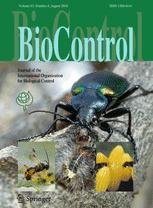Ver ítem
- xmlui.general.dspace_homeCentros Regionales y EEAsCentro Regional Santa FeEEA RafaelaArtículos científicosxmlui.ArtifactBrowser.ItemViewer.trail
- Inicio
- Centros Regionales y EEAs
- Centro Regional Santa Fe
- EEA Rafaela
- Artículos científicos
- Ver ítem
Laboratory and field studies to evaluate the potential of an open rearing system of Lysiphlebus testaceipes for the control of Aphis craccivora in Argentina
Resumen
The aim of this work was to examine, both in the field and in the laboratory, ecological aspects of selected plant–aphid–parasitoid interactions to evaluate their potential for the open rearing of the parasitoid Lysiphlebus testaceipes (Cresson) (Hymenoptera: Aphidiinae) for the control of Aphis craccivora (Koch) (Hemiptera: Aphididae) in alfalfa agroecosystems. To this end quantitative samplings of parasitoids and aphids were made fortnightly in three
[ver mas...]
The aim of this work was to examine, both in the field and in the laboratory, ecological aspects of selected plant–aphid–parasitoid interactions to evaluate their potential for the open rearing of the parasitoid Lysiphlebus testaceipes (Cresson) (Hymenoptera: Aphidiinae) for the control of Aphis craccivora (Koch) (Hemiptera: Aphididae) in alfalfa agroecosystems. To this end quantitative samplings of parasitoids and aphids were made fortnightly in three alfalfa crop fields and their spontaneously vegetated edges, in Rafaela (Santa Fe, Argentina), during three years (2009–2011). Three sink webs based on L. testaceipes, on a per-year basis, were constructed to assess the strength of the interactions established by aphids and parasitoids, the host ranges of alternative aphid species, and the tendencies in parasitoid host use across years. In the laboratory, emergence rates, parasitism rates, larval and pupal development times, and adult lifespan of L. testaceipes were analyzed by means of choice tests, including the alternative and the target aphid species in the assays. About 84 % of adults of L. testaceipes obtained in the samples came from Aphis nerii (Boyer de Fonscolombe), an innocuous aphid species only associated with plants of the genus Araujia Brotero (Apocynaceae). Based on our results, the system proposed has many features that support its feasibility to be used as an open rearing system of L. testaceipes: unrisky alternative aphid, easy reproduction of the banker plant and similar suitability of innocuous and pest aphid species for the parasitoid to oviposit and complete their development without noticeably preference for specific hosts.
[Cerrar]

Autor
Zumoffen, Leticia;
Tavella, Julia Rita;
Signorini, Marcelo;
Salvo, Silvia Adriana;
Fuente
BioControl 61 (1) : 23–33 (February 2016)
Fecha
2016-02
ISSN
1386-6141
1573-8248
1573-8248
Formato
pdf
Tipo de documento
artículo
Palabras Claves
Derechos de acceso
Restringido
 Excepto donde se diga explicitamente, este item se publica bajo la siguiente descripción: Creative Commons Attribution-NonCommercial-ShareAlike 2.5 Unported (CC BY-NC-SA 2.5)
Excepto donde se diga explicitamente, este item se publica bajo la siguiente descripción: Creative Commons Attribution-NonCommercial-ShareAlike 2.5 Unported (CC BY-NC-SA 2.5)

